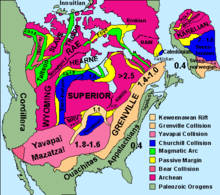Fáìlì:North america terrain 2003 map.jpg
Ìrísí

Ìtóbi ìkọ́yẹ̀wò yìí: 673 × 599 pixels. Àwọn ìgbéhàn míràn: 270 × 240 pixels | 539 × 480 pixels | 863 × 768 pixels | 1,150 × 1,024 pixels | 2,300 × 2,048 pixels | 3,300 × 2,938 pixels.
Fáìlì àtìbẹ̀rẹ̀ (3,300 × 2,938 pixel, ìtóbi faili: 1.66 MB, irú MIME: image/jpeg)
Ìtàn fáìlì
Ẹ kan kliki lórí ọjọ́ọdún/àkókò kan láti wo fáìlì ọ̀ún bó ṣe hàn ní àkókò na.
| Ọjọ́ọdún/Àkókò | Àwòrán kékeré | Àwọn ìwọ̀n | Oníṣe | Àríwí | |
|---|---|---|---|---|---|
| lọ́wọ́ | 15:21, 16 Oṣù Òwéwe 2005 |  | 3,300 × 2,938 (1.66 MB) | Saperaud~commonswiki | Relief map showing the varying age of bedrock underlying North America. thumb|150px|right|Time scale for [[:Image:North america terrain 2003 map.jpg|North America terrain ]] This cartographic t |
Ìlò fáìlì
Àwọn ojúewé 2 wọ̀nyí únlo fáìlì yí:
Ìlò fáìlì káàkiri
Àwọn wiki míràn wọ̀nyí lo fáìlì yìí:
- Ìlò ní af.wikipedia.org
- Ìlò ní ar.wikipedia.org
- Ìlò ní arz.wikipedia.org
- Ìlò ní bn.wikipedia.org
- Ìlò ní de.wikipedia.org
- Ìlò ní el.wikipedia.org
- Ìlò ní en.wikipedia.org
- North America
- User:SEWilco
- Geologic map
- User:SEWilco/Images
- Wikipedia:Featured picture candidates/April-2005
- Wikipedia:Picture of the day/June 2005
- Wikipedia:Featured picture candidates/North america terrain 2003 map.jpg
- Wikipedia:Featured pictures thumbs/02
- Wikipedia:Wikipedia Signpost/2005-05-02/Features and admins
- Wikipedia:POTD/June 19, 2005
- Wikipedia:Picture of the day/June 19, 2005
- History of Earth
- User:Cyde/Featured pictures
- Portal:North America/Selected picture
- Portal:Maps/Selected picture
- Geography of North America
- User:Striver/Pictures
- Wikipedia:WikiProject Canada/Featured and good content
- Wikipedia:Picture of the day/April 2007
- Portal:Geology
- Template:POTD/2007-04-21
- Portal:Maps/Selected picture/15
- Wikipedia:Featured pictures/Diagrams, drawings, and maps/Maps
- Portal:Canada/Featured content
- Portal:Canada/Indices
- Portal:North America/Selected picture/19
- Geologic mapping of Georgia (U.S. state)
- Wikipedia:WikiProject United States/Recognized content
- Wikipedia:WikiProject United States/Quality content
- User:Avenue/sandbox
- Geology of North America
- Wikipedia talk:WikiProject Geology/Archive 3
- Talk:Geology of the United States/Archive 1
- Wikipedia:WikiProject United States/Featured pictures
- Portal:World
- Portal:Geology/Selected picture
- Wikipedia:Wikipedia Signpost/Single/2005-05-02
- User:Geothraner
- User talk:Geothraner
- Ìlò ní en.wikiquote.org
Ìfihàn ìlò míràn púpọ̀ fún fálì yìí.









